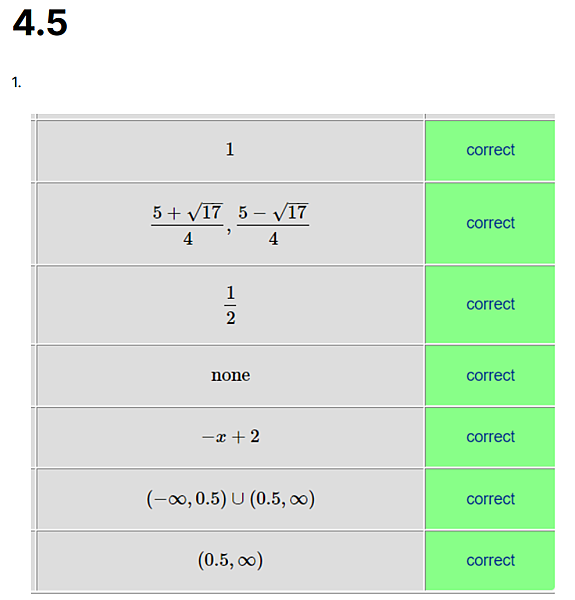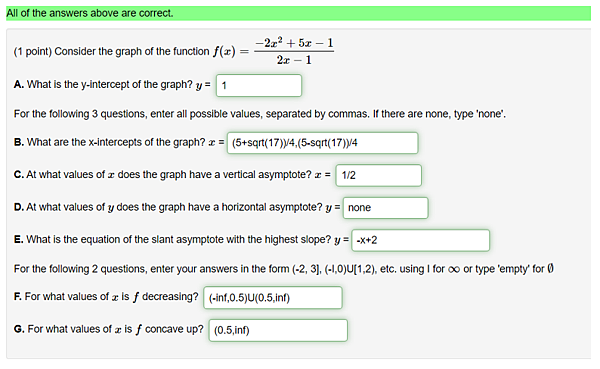





Consider the graph of the function f(x)=−2x2+5x−12x−1
A. What is the y-intercept of the graph? y =
For the following 3 questions, enter all possible values, separated by commas. If there are none, type 'none'.
B. What are the x-intercepts of the graph? x =
C. At what values of x does the graph have a vertical asymptote? x =
D. At what values of y does the graph have a horizontal asymptote? y =
E. What is the equation of the slant asymptote with the highest slope? y =
For the following 2 questions, enter your answers in the form (-2, 3], (-I,0)U[1,2), etc. using I for ∞ or type 'empty' for ∅
F. For what values of x is f decreasing?
G. For what values of x is f concave up?
Consider the graph of the function f(x)=ex−8x
A. What is the y-intercept of the graph? y =
B. How many x-intercepts are there? There are x-intercepts
For the following question, enter all possible values, separated by commas. If there are none, type 'none'.
C. At what values of x does the graph have a vertical asymptote? x =
D. What is the equation of the slant asymptote with the highest slope? y =
For the following 2 questions, enter your answers in the form (-2, 3], (-I,0)U[1,2), etc. using I for ∞ or type 'empty' for ∅
E. For what values of x is f decreasing?
F. For what values of x is f concave up?
Consider the graph of the function f(x)=x2+4x−−−−−−√
For the following question, enter your answers in the form (-2, 3], (-I,0)U[1,2), etc. using I for ∞ or type 'empty' for ∅
A. What is the domain of the function?
B. What is the y-intercept of the graph? y =
For the following 2 questions, enter all possible values, separated by commas. If there are none, type 'none'.
C. What are the x-intercepts of the graph? x =
D. At what values of x does the graph have a vertical asymptote? x =
E. What is the equation of a slant asymptote with positive slope? y =
Hint: If you would like to understand an expression of the form x2+4x−−−−−−√−(mx+b) it helps to multiply by the expression x2+4x√+(mx+b)x2+4x√+(mx+b)=1 and then choose m and b so that there is a large amount of cancellation in the numerator.
For the following 2 questions, enter your answers in the form (-2, 3], (-I,0)U[1,2), etc. using I for ∞ or type 'empty' for ∅
F. For what values of x is f decreasing?
G. For what values of x is f concave up?
Suppose that
(A) Find all critical values of f. If there are no critical values, enter None . If there are more than one, enter them separated by commas.
Critical value(s) =
(B) Use interval notation to indicate where f(x) is increasing.
Note: When using interval notation in WeBWorK, you use I for ∞, -I for −∞, and U for the union symbol. If there are no values that satisfy the required condition, then enter "{}" without the quotation marks.
Increasing:
(C) Use interval notation to indicate where f(x) is decreasing.
Decreasing:
(D) Find the x-coordinates of all local maxima of f. If there are no local maxima, enter None . If there are more than one, enter them separated by commas.
Local maxima at x =
(E) Find the x-coordinates of all local minima of f. If there are no local minima, enter None . If there are more than one, enter them separated by commas.
Local minima at x =
(F) Use interval notation to indicate where f(x) is concave up.
Concave up:
(G) Use interval notation to indicate where f(x) is concave down.
Concave down:
(H) Find all inflection points of f. If there are no inflection points, enter None . If there are more than one, enter them separated by commas.
Inflection point(s) at x =
(I) Use all of the preceding information to sketch a graph of f. When you're finished, enter a 1 in the box below.
Graph Complete:





 留言列表
留言列表


